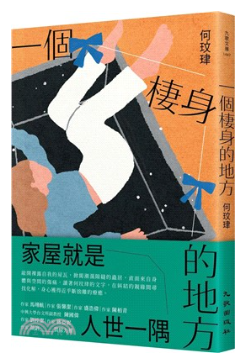
《一個棲身的地方》
- 簡介:
家屋就是人世一隅
敲開裸露自我的屋瓦,掀揭潮濕隙縫的蟲居,直面來自身體與空間的傷痛,
讀著何玟珒的文字,在糾結的親緣間尋找化解,身心獲得近乎斷捨離的療癒。
榮獲台灣文學金典獎的新世代作家何玟珒,繼備受矚目的小說集《那一天我們跟在雞屁股後面尋路》後,首度出版散文集《一個棲身的地方》,描述遷移、逃離、暫住或長居的那些住所,書寫家族間的愛恨交織。
全書分為四輯,「空間書」記錄作者所待過的房間,並援引建築史發展脈絡來闡述空間產生的意義。同名篇章〈一個棲身的地方〉,寫母女三人不停地遷居,以及儲物症的母親如何安排女兒的房間,用女兒來寄居她的匱乏,把丟掉可惜的舊衣置放在女兒的衣櫥。「身體書」將個人的身體視為一個權力場域,透過掠龍的〈傳導痛〉和做臉的〈面子問題〉,觀察母親如何塑養孩子的體膚,以及親子掌控權拉扯的微小角力。「舌頭書」藉由學習語言的歷程,思考自己在使用語言的背後所認同的我父(本省第二代)與我母(外省第二代)之歷史,微觀舌上之語,映照經歷兩種不同脈絡的〈少女政治史〉。「家族書」透過〈父女〉與祖父往生的〈告別式〉,講述個人對原生家庭接近與斷捨離的家族史。
身體不光是被動盛裝的容器,銘刻學習的經驗、遭受的苦痛與生活的因果;身體作為一個棲身的地方,亦主動以舌頭五感和外在的環境、周遭的人們互動。何玟珒敲開裸露自我的屋瓦,掀揭潮濕隙縫的蟲居,直面她幽微的、來自身體與空間的、難以言說卻迴避不了的種種傷痛。她在不成眠的夜間散步尋求平靜,在糾結的親緣間尋找化解,遊走於感性抒情與理性論辯的敘事結構中,一筆一畫專注地鑽切和剖面自己,試圖把所有長滿蟲蝨的衣服與居所,光雕成華美的生命的殿堂。
- 英文簡介
A home is but a corner of the human world.
Knocking open the roof tiles that expose the self, revealing the insect nests hidden in damp crevices, facing the pain from both body and space,
Reading the words of Wun-Jin He, seeking resolution among the tangled familial bonds, achieving a kind of healing akin to decluttering the mind and body.
Wun-Jin He, a new generation writer who won the Taiwan Literary Classic Award, following the highly anticipated short story collection That Day, We Followed the Chicken’s Butt to Find Our Way, publishes her first essay collection A Place to Nest. The book describes residences where people migrate, escape, temporarily stay, or permanently dwell, writing about the love-hate entanglements within families.
The book is divided into four sections:
The “Space Writing” records the rooms the author has lived in, drawing from the development of architectural history to explain the meanings produced by these spaces. The title essay A Place to Nest describes the constant relocation of a mother and her two daughters, and how the mother with hoarding tendencies arranges her daughter’s room, using her daughter to fill the emptiness within herself, placing discarded but valuable old clothes in her daughter’s closet.
The “Body Writing” views the body as a field of power, examining through the stories Conduction of Pain and Facial Issues how the mother shapes her children’s bodies and the subtle power struggles between parents and children over control.
The “Tongue Writing” reflects on the process of learning language, considering the histories of the author’s father (second generation of native-born Taiwanese) and mother (second generation of mainland Chinese), and how these backgrounds influence her own identity. The microcosm of language, seen in The Politics of Girlhood, reflects the experience of two different historical contexts.
The “Family Writing” shares stories of the relationship between father and daughter, and a farewell to a grandfather, exploring personal proximity to or detachment from the original family’s history.
The body is not just a passive container; it engraves the experiences learned, the pains endured, and the causalities of life. The body, as a place to nest, also actively interacts with its surroundings, its environment, and the people around it through its five senses and tongue. Wun-Jin He knocks open the exposed roof tiles of her self, uncovering the insect nests in the damp crevices, facing the subtle and inescapable pains originating from both her body and space. She seeks peace through nighttime walks, finding resolution within the tangled familial bonds, moving between emotional lyricism and rational argument in her narrative structure. With each stroke, she focuses on drilling and dissecting herself, attempting to transform all the clothes and dwellings infested with lice into a magnificent hall of life, illuminated by light.
- 通路
- 電子書通路
